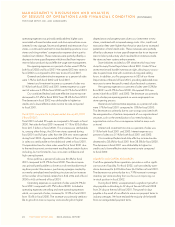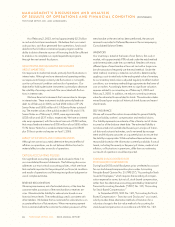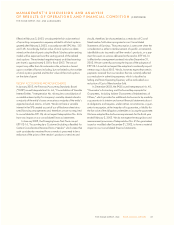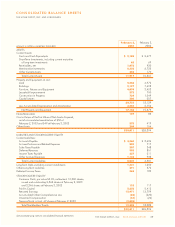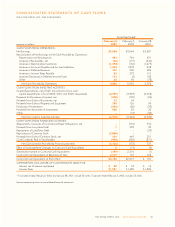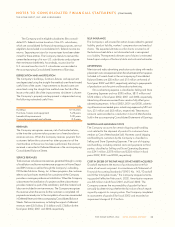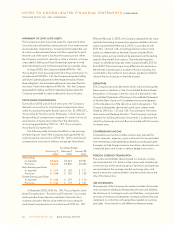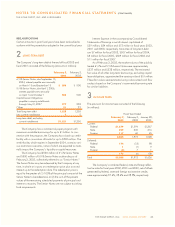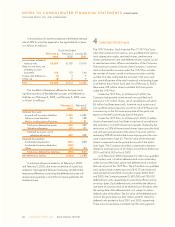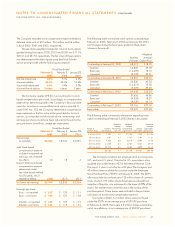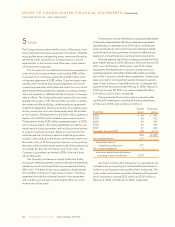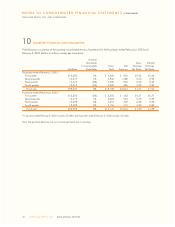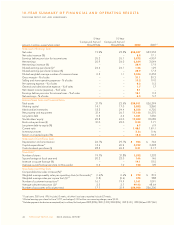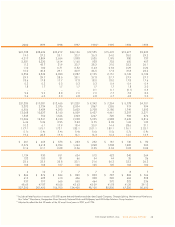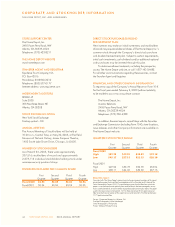Home Depot 2002 Annual Report Download - page 36
Download and view the complete annual report
Please find page 36 of the 2002 Home Depot annual report below. You can navigate through the pages in the report by either clicking on the pages listed below, or by using the keyword search tool below to find specific information within the annual report.
NOTES TO CONSOLIDATED FINANCIAL STATEMENTS (CONTINUED)
THE HOME DEPOT, INC. AND SUBSIDIARIES
IMPAIRMENT OF LONG-LIVED ASSETS
The Company reviews long-lived assets for impairment when
circumstances indicate the carrying amount of an asset may not
be recoverable. Impairment is recognized to the extent the sum
of undiscounted estimated future cash flows expected to result
from the use of the asset is less than the carrying value. When
the Company commits to relocate or close a location, a charge
is recorded to Selling and Store Operating Expenses to write
down the related assets to the estimated net recoverable value.
In August 2002, the Company adopted SFAS No. 146,
“Accounting for Costs Associated with Exit or Disposal Activities.” In
accordance with SFAS No. 146, the Company recognizes Selling
and Store Operating Expense for the net present value of future
lease obligations, less estimated sublease income when the loca-
tion closes. Prior to the adoption of SFAS No. 146, the Company
recognized this Selling and Store Operating Expense when the
Company committed to a plan to relocate or close a location.
STOCK-BASED COMPENSATION
During fiscal 2002 and all fiscal years prior, the Company
elected to account for its stock-based compensation plans
under Accounting Principles Board Opinion No. 25 (“APB 25”),
“Accounting for Stock Issued to Employees,” which requires
the recording of compensation expense for some, but not all,
stock-based compensation rather than the alternative
accounting permitted by SFAS No. 123, “Accounting for
Stock-Based Compensation.”
The following table illustrates the effect on net earnings
and earnings per share if the Company had applied the fair
value recognition provisions of SFAS No. 123 to stock-based
compensation (amounts in millions, except per share data):
Fiscal Year Ended
February 2, February 3, January 28,
2003 2002 2001
Net Earnings
As reported $3,664 $3,044 $2,581
Pro forma $3,414 $2,800 $2,364
Basic Earnings per Share
As reported $ 1.57 $ 1.30 $ 1.11
Pro forma $ 1.46 $ 1.20 $ 1.02
Diluted Earnings per Share
As reported $ 1.56 $ 1.29 $ 1.10
Pro forma $ 1.46 $ 1.19 $ 1.01
In December 2002, SFAS No. 148, “Accounting for Stock-
Based Compensation –Transition and Disclosure,” was issued,
which provides three alternative methods of transition for a
voluntary change to the fair value method of accounting for
stock-based compensation in accordance with SFAS No. 123.
Effective February 3, 2003, the Company adopted the fair value
method of recording compensation expense related to all stock
options granted after February 2, 2003, in accordance with
SFAS Nos. 123 and 148. Accordingly, the fair value of stock
options as determined on the date of grant using the Black-
Scholes option-pricing model will be expensed over the vesting
period of the related stock options. The estimated negative
impact on diluted earnings per share is approximately $.02 for
fiscal 2003. The actual impact may differ from this estimate as
the estimate is based upon a number of factors including, but
not limited to, the number of stock options granted and the fair
value of the stock options on the date of grant.
DERIVATIVES
The Company measures derivatives at fair value and recognizes
these assets or liabilities on the Consolidated Balance Sheets.
Recognition of changes in the fair value of a derivative in the
Consolidated Statements of Earnings or Consolidated Statements
of Stockholders’ Equity and Comprehensive Income depends
on the intended use of the derivative and its designation. The
Company designates derivatives based upon criteria estab-
lished by SFAS Nos. 133 and 138, “Accounting for Derivative
Instruments and Hedging Activities.” The Company’s primary
objective for holding derivative instruments is to decrease the
volatility of earnings and cash flow associated with fluctuations
in interest rates.
COMPREHENSIVE INCOME
Comprehensive income includes net earnings adjusted for
certain revenues, expenses, gains and losses that are excluded
from net earnings under generally accepted accounting principles.
Examples include foreign currency translation adjustments and
unrealized gains and losses on certain hedge transactions.
FOREIGN CURRENCY TRANSLATION
The assets and liabilities denominated in a foreign currency
are translated into U.S. dollars at the current rate of exchange
on the last day of the reporting period. Revenues and expenses
are translated at the average monthly exchange rates, and
equity transactions are translated using the actual rate on the
day of the transaction.
USE OF ESTIMATES
Management of the Company has made a number of estimates
and assumptions relating to the reporting of assets and liabilities,
the disclosure of contingent assets and liabilities, and reported
amounts of revenues and expenses in preparing these financial
statements in conformity with generally accepted accounting
principles. Actual results could differ from these estimates.
34 THE HOME DEPOT, INC. 2002 ANNUAL REPORT


